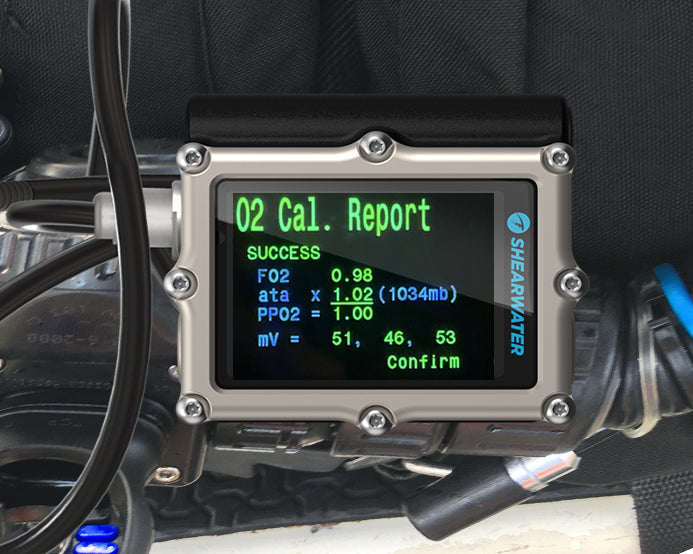Cables in a rebreather system are vulnerable to damage due to their exposed nature, making them susceptible to abrasion, impacts, and environmental wear. This guide provides essential care and maintenance tips for two types of cables used in Shearwater products: DiveCAN cables (digital 5-pin) and AK 4-pin cables (analog 4-pin).
These cables each consist of two parts: a male connector and a female connector (or female bulkhead), designed to interconnect securely. The male and female connectors can (and should) be disconnected in some instances such as for maintenance work or troubleshooting.
These connectors are intended to be a convenient way to separate components (such as Petrels, Nerds and LED HUDs) from the main rebreather body should there be a need for service or repair. The connectors are not intended for frequent or routine disconnection, the connectors should remain mated when in use and when stored.
These connectors are durable, and with proper care, should provide years of reliable performance. To ensure the longest life and the most reliable operation of the connectors, please observe the following guidelines.

Do not mate the connectors when wet.
In the case of DiveCAN connectors, one of the pins is a power source and another is a ground connection. If the system is energized in salt water (or fresh water with sufficient mineral content) an electrical path will be created, and the resulting chemistry will corrode the power pin quickly. The four pin connectors do not carry the same voltage but should still be cared for in the same manner. If DiveCAN connectors get wet with salt water, remove the battery from the controller handset, rinse connector with fresh water, drain and dry, then lubricate.
Lubricate DiveCAN connectors with a light coating of pure mineral oil or a dielectric grease such as Molykote 111, or Electrolube CG60. Both non-conductive dielectric grease and conductive contact lubricants, such as Electrolube CG60, are acceptable for use with DiveCAN connectors. The primary purpose of the lubricant is to protect the connector during insertion and ensure smooth mating/de-mating. Please be aware that these contact lubricants are not designated as oxygen-compatible and should not be used in high-pressure oxygen or oxygen-enriched gas systems in scuba diving equipment. They are intended solely for use in connectors. Exercise caution to prevent cross-contamination and handle with the utmost care.
Electrical contact will occur regardless of whether a dielectric or conductive lubricant is used. Only a very small amount of lubricant should be applied—just enough to make the black sealing surfaces around each pin shiny. Applying too much lubricant can create hydraulic pressure inside the connector, potentially damaging the watertight seal. Starting in 2025 a small vial of CG60 is included with new Petrel 3 and Nerd 2 units.

Always ensure both female and male connectors are clear of debris before mating.
Foreign material, such as sand, salt particles, dust, dirt, etc., can interfere with the proper functioning of the connectors, potentially causing leaks and / or damage the pins.
When mating and un-mating cable-to-cable connectors use two hands, one grasping each side of the connector.
This is the best method for providing proper support and alignment. Ensure the mated connectors are fully engaged, with minimal gap between each end.

Always use the correct strain relief as recommended by the manufacturer of your rebreather.
A strain relief will reduce the chance of the cables becoming separated during use and, consequently, suffering the effects of corrosion. There are three strain relief systems: a rigid strain relief, a soft strain relief, and a JJ-CCR style strain relief.
The rigid strain relief style is a screw together arrangement. This assembly is made of a female body, a male cap, and two split plastic rings. See instructions to install below.



Installed rigid strain relief kit
The soft strain relief style is a clasp arrangement. This assembly is made of a soft plastic sheat body and two o-rings.

Soft strain relief install instructions:

1. Install O-rings before mating cable 2. Install sheath over cable then slide O-rings in place at each end
The JJ-CCR style strain relief style is a screw on head arrangement. This assembly is made of a hard plastic T- body that is screwed to the JJ-CCR rebreather head. See instructions to install below. Note: this strain relief is factory pre-installed on JJ-CCR specific items.

JJ Strain relief shroud correctly screwed to head.
The strain relief is screwed to the head of the rebreather using two screws and has a rigid plastic shroud which ensures the correct alignment and security of the connectors. The screws only need to be tight enough to ensure the shroud is touching the head and the screws are secure, there is no need to apply high torque to these screws.
By following these guidelines, you can maximize the lifespan and reliability of these durable connectors, ensuring years of dependable performance.
---
Original Article Written By Rob Edward from the Shearwater Asia Pacific Service Centre in New Zealand. Updated in 2025 by Jose Ventura from Shearwater Head Office in Canada.





